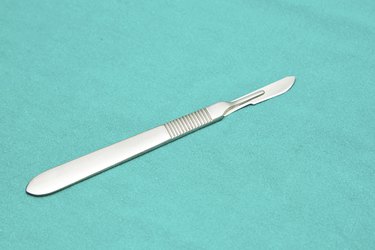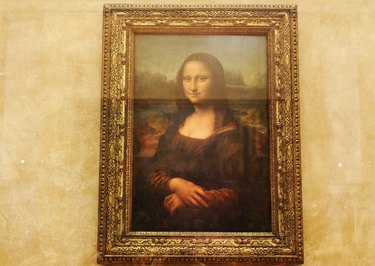
The Renaissance, which followed the medieval period in Europe and dominated the 14th through the 16th centuries, produced an explosion of innovative and hybrid painting techniques. Artists sought fame and glory along with patrons and commissions, and the best became Renaissance rock stars, celebrated for their embrace of new techniques as well as their talent and skill. The architect Brunelleschi calculated linear perspective, Leonardo da Vinci and Michelangelo dissected corpses to better capture human anatomy, Raphael played with light and dimension, and Titian and Tintoretto suffused their work with intense color to express vitality and emotion.
All in the Perspective
Video of the Day

The mathematical precision of architectural linear perspective, applied to painting, allowed Renaissance artists to create a sense of real dimension in their work. By painting subjects so that they became smaller and appeared to vanish into the distance, artists added depth and the illusion of rounded, whole shapes to flat stucco walls or canvas. The paintings seemed to come alive, to show real life and people, not two-dimensional painted shapes. Blurred edges on distant objects mimicked the effect of the atmosphere on what the eye could see. Vivid color in the foreground, gradually fading into murkier blues and greens in the background, enhanced the "distant" vista. Another perspective trick, planar perspective, separates a canvas into planes. In Leonardo's "Mona Lisa," the foreground is the colorful figure, the middle plane is a distinct section of brown and green trees, and the distant plane is mostly blue.
Video of the Day
Fast-Drying Fresco

Fresco technique was a holdover from medieval painting that was widely used to decorate Renaissance churches, public buildings and villas -- Leonardo's "Last Supper," created on a refectory wall in Milan, is an experiment with true fresco form. The technique requires painting directly on fresh, wet plaster so the color dries right into the hardened wall. Leonardo tried painting in layers on the dried wall -- fresco a secco -- like egg tempera technique on a wood panel or canvas, which meant his work quickly began to crack and flake. Fresco was more popular in drier cities like Florence than in the humid damp of Venice, where plaster crumbled and disintegrated.
Lapis Lazuli, Oil Paint and Vendecolori

The adoption of oil as a pigment medium, rather than traditional egg tempera, unleashed an explosion of color and inventive refinements in painting that were not possible with faster-drying media. Oil paint was translucent and would glow, jewel-like, on the canvas in the hands of a master. Oil could be worked and reworked before it dried, and that led artists to experiment with a wide range of newly available pigments. The pigment merchants, called vendecolori, traded in exotic colors such as vermilion, azurite, cochineal, lapis lazuli, indigo, madder, malachite and several tree resins from distant locations as far away as China, Cambodia and India.
The Colorito vs. Disegno Debate

Renaissance art was not without its rivalries and disagreements. Disegno, which means drawing in Italian, was at the heart of artistic creation in Florence, where art was an intellectual engagement and a careful attempt to capture the true outlines of nature was prized. The perfection of draftsmanship was equated with a godlike ability to create across all art forms -- painting, sculpture and architecture. Michelangelo was one of the Florentines who drew their designs on parchment or paper before transferring the image to canvas and painting it. In Venice, colorito -- color and its application -- conveyed the vivid, messy passion of life through art. Colorists like Titian preferred the more naturalistic approach to making art: layering, blending and enhancing pigments directly on the canvas; then softening the edges to remove all evidence of application so their paintings would glow as if alive.
The Body Beneath the Skin

The effort to make art natural through accuracy led to clandestine dissections of corpses by artists in an attempt to understand the musculature and skeletal structure of the human body. The powerful Roman Catholic Church, along with social convention, considered dissection to be a desecration, so artists acquired corpses and conducted their studies covertly. The study of anatomy was particularly avid among the Florentines -- Michelangelo and Leonardo were just two of the artists who wielded a scalpel before a chisel or paintbrush. What this meant to painting was an increased demand from art patrons for mastery of the human body and accurate depiction of the bones and muscles beneath the skin.
Chiaroscuro, Light Illusion

Painted art is two-dimensional; chiaroscuro visually tricks the eye into seeing three dimensions and a more realistic depiction of life. Chiaroscuro, Italian for "light" and "dark," is exactly that -- the use of highlights and shadow to simulate the fall of light on a three-dimensional object. A painter imagines light shining on his subject, then highlights the hot spot where the light hits most intensely with the lightest pigment, usually white. Shadows extend and deepen from the painted forms according to their relationship to the light source. Italian Renaissance painters Leonardo and Raphael made frequent use of chiaroscuro. In 17th-century Amsterdam, Rembrandt would gain lasting fame from his skillful use of this Renaissance technique.
Smoky, Enigmatic Sfumato

"Mona Lisa's" smile isn't the only mysterious thing about her. The painting is a classic example of the sfumato technique -- oil painting in which colors are softly blended and toned down to erase transitions and subtly draw the eye from dark to light. Sfumato uses several translucent glazes to achieve this effect -- a sort of smoky, hazy treatment without visible edges or lines. The technique creates a veil of see-through shadow that dims the brightest colors and softens the darkest tones. Correggio, Leonardo and Raphael subtly smoothed their paintings with sfumato technique.
- National Gallery of Art: 16th-Century Renaissance Pigments and Painting Techniques
- Oxford Art Online: Renaissance Art and Architecture
- European University Institute: Italian Renaissance Art
- History Channel: Renaissance Art
- Metropolitan Museum of Art: Leonardo da Vinci (1452–1519)
- Metropolitan Museum of Art: Anatomy in the Renaissance
- Oxford Art Online: Renaissance Paragone -- Disegno and Colore
- Metropolitan Museum of Art: Venetian Color and Florentine Design
- Louvre: Mona Lisa – Portrait of Lisa Gherardini, Wife of Francesco del Giocondo
- Metropolitan Museum of Art: Italian Painting of the Later Middle Ages
- Italian Renaissance Art.com: Painting Techniques of the Renaissance -- The Fresco Technique
- Essential Humanities: Renaissance Painting